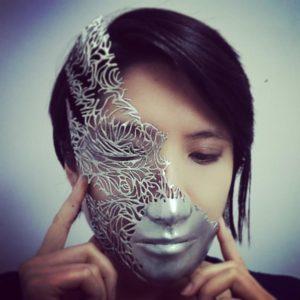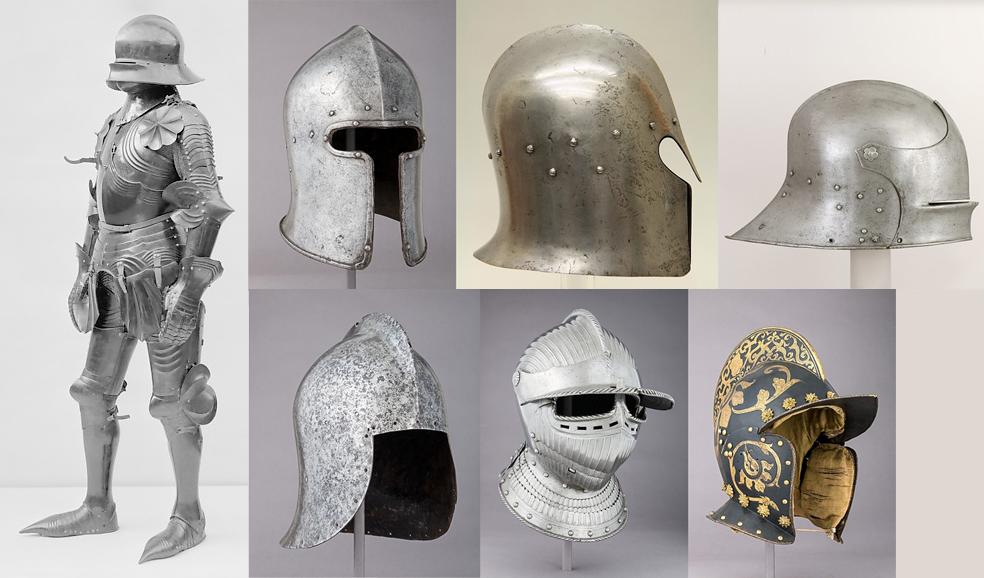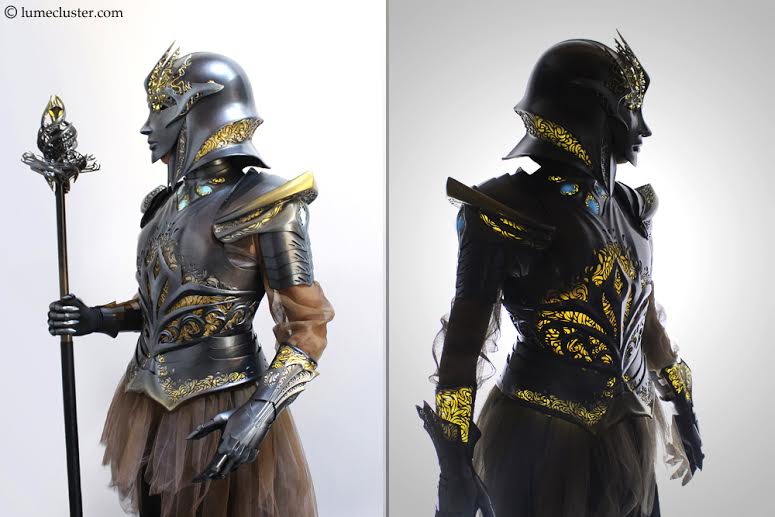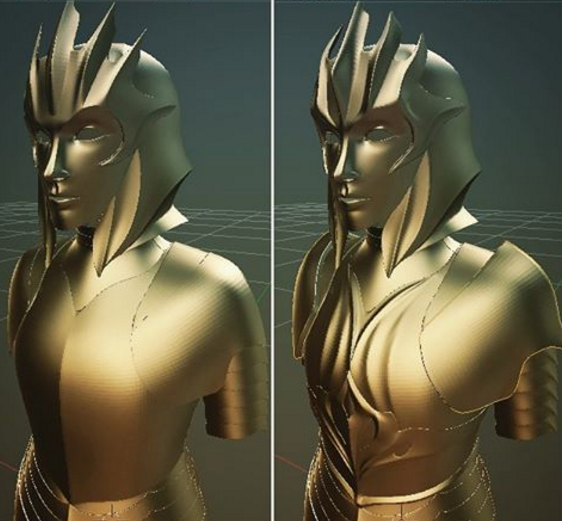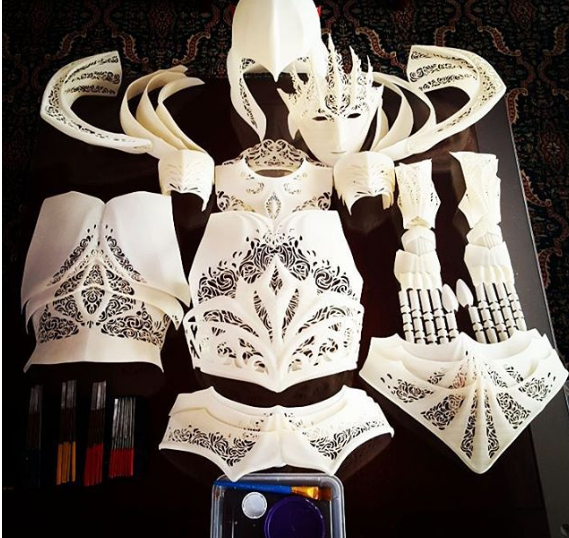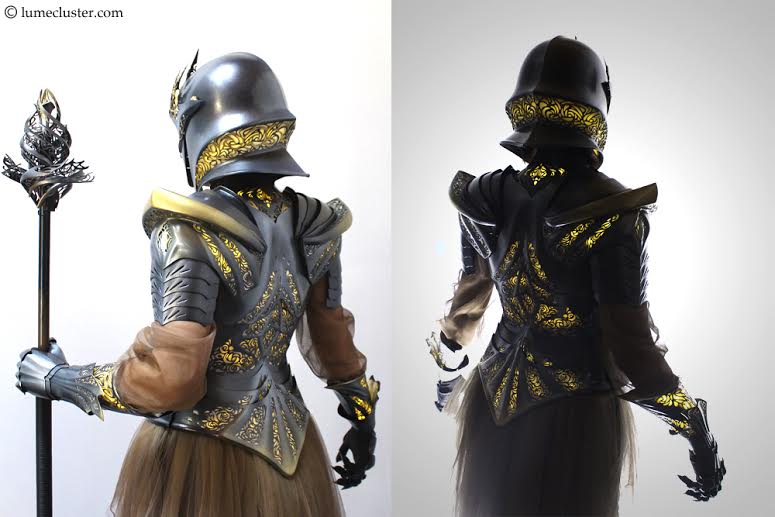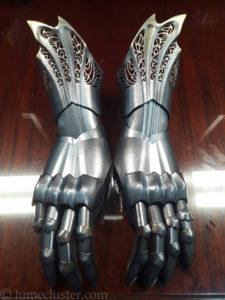Fearless (in 3D printing). Vulnerable (as a human, and an artist). Brave (in the face of criticism). Driven (as a creator). She’s bold yet humble, and experienced—yet still a beginner. Melissa Ng is quite simply…very complex. Bringing new meaning to releasing the inner warrior, Ng has elevated the concept to an unprecedented level personally and artistically—invoking her warrior princess and putting her before us in physical form—ready to accept judgment regarding her aesthetics and authenticity from a public that is supportive and nurturing on one hand and sometimes caustic and critical on the other.
As Melissa Ng refines her armor, that warrior grows, stronger in spirit and artistic testament, stronger against negative forces. Today, against a backdrop of ethereal masks that represent emotions of the artist and also cause them to well up from inside the viewer, 3D printed and nightmarish as well as lifelike and lovely with detailed finishing, we are able to see through to the artist and recognize here what is indeed true talent in the life of a creative: growth. This is on full display with a fascinating body of work that continues to get better and better.
Extending her craft in design and 3D printing from masks to armor and female fantasy wear/cosplay, Ng is engaged in a new education that now has allowed for wondrous comparison between the Dreamer Regalia 3D Printed Cosplay Armor she ended up centering around outspoken ‘geek goddess’ Felicia Day, and her latest 3D printed project: Sovererign Armor. Ng described this new project to us as ‘different and massively more complex.’ putting words to exactly what we were, stunned, trying to express upon viewing the women’s fantasy armor.“It’s medieval-inspired, modular (can be mixed and matched to create multiple outfits), and practical fantasy armor for women,” Ng told 3DPrint.com. “It’s also flexible enough to fit a few different figures.”
As she delved much further into the world of armor, Ng told us also that she worked with Ian LaSpina (aka Knyght Errant) as her armor consultant while she was working on Sovereign Armor. As a historical armor educator, La Spina had much to offer the artist as she began exploring many different—and entrancing—styles, especially that of 15th century gothic.
This latest project is based on a growing fascination with the world of armor, epic and ancient, as well as a bit of an answer for the first endeavor, where Ng admits she was just enjoying her work, drawing designs without being completely knowledgeable.
“Coming from a background in media studies and marketing, the researcher in me collected and studied thousands of comments and discussions on the Dreamer Regalia armor,” says Ng at Lumecluster. “I noticed a few interesting trends.”
“There were many disputes on armor practicality and countless people passive aggressively defining ‘cosplay’ and ‘fantasy’ to each other as an ‘art where you’re allowed to make up and create whatever you want.’ And while I agree that that’s the beauty of fantasy, I’d hate for it to be used as an excuse to shut ourselves away from listening to other ideas and opportunities to learn something new (assuming that it’s a mature and non-hostile discussion…).”
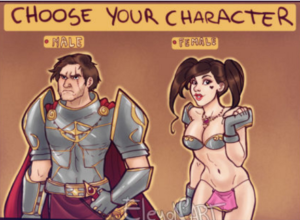 And as this is dealing with women’s fantasy wear, not surprisingly, the sex angle rear its head as numerous men and women discussed the breastplate from both an authentic angle as well as one just focused on, well, boobs. Or the lack thereof. While the first project certainly offered much more than a vehicle for breasts, some of the focus went quite off track in the comments, with Ng quite offended as those who railed at others as ‘idiots’ and more.
And as this is dealing with women’s fantasy wear, not surprisingly, the sex angle rear its head as numerous men and women discussed the breastplate from both an authentic angle as well as one just focused on, well, boobs. Or the lack thereof. While the first project certainly offered much more than a vehicle for breasts, some of the focus went quite off track in the comments, with Ng quite offended as those who railed at others as ‘idiots’ and more.
While nothing is more unpleasant than watching the children misbehave, their discussions serve as a statement regarding how provocative the artwork is, evoking passion over the aesthetics, as well as potential functionality. Ng does take the opportunity to point out that women in armor can look quite feminine without showing off their breasts, and she offers up a rather bodacious and comical example—exemplifying what she is not out to produce. Here, she realized a growing urge to create ‘practical and versatile Medieval-inspired fantasy armor for a woman.’
That urge grew into 518 hours, birthing a suit of armor weighing eight pounds, named Sovereign Armor as a nod to all of the brave creatives in the world who most likely experience a great deal of loneliness as well. As we all know, it’s easy to follow the masses and feel like part of a safe crowd, but having the courage of your convictions—and the tough inner spirit often required to take the risk and let your light shine—can indeed narrow you down to a team of…one.The craft and the care put into this work is nothing less than breathtaking. If you’re in need of some artistic inspiration today, just watch the video below, offering us the privilege of taking a glimpse into some of the journey Ng traveled in creating her latest work.“Maybe you’ve encountered people who try to douse your flames or complications start getting in your way. Or perhaps the people you once admired are now on a mission to tear you down, dismiss your hard work or make you feel ‘less than.’ It hurts, but if you care about what you create, you’ll keep standing up to fight and constantly re-fuel that fire,” inspires Ng.
From the polishing to the painting and finishing touches, Ng allows us to see the artist’s hand in the process of creating, and there is undeniable magic at work. Taking the time to break down all 518 hours of work—which do not include 3D printing—Ng begins with explaining how she spent a full 88 hours in comprehensive research and development. With the goal of creating more practical armor, Ng began with Google, moved on to purchasing textbooks, and in the end, found herself at the Metropolitan Museum of Art studying armor.
At that point, Ng began working intensively with Ian LaSpina. She spent time watching all of his videos, and found the content on his YouTube channel as well as his website to be chock full of content regarding history, armor, cosplay, and much more. After consuming so much valuable knowledge online, she then too invited him to be her consultant as she needed more guidance, despite the plethora of design styles before her.“The Sovereign Armor’s extremely flexible (and porous) elasto plastic material (printed via Shapeways) is completely different than the Dreamer Regalia (nylon), which meant I had a ton of new things to think about,” said Ng. “For instance, I spent a lot of time testing new materials, paints, glow powders, and finishes that would work with the elasto plastic surface. I also felt 10 times more obsessive over the little details since this was, once again, a one shot 3D print.”
“I eventually decided I was most drawn to the 15th century German Gothic armor style and all of its beautiful fluting. I was also in love with the burgonet, sallet, and barbute helmet styles,” said Ng.
LaSpina reviewed her progress ‘every step of the way’ seeing that her design was practical and comfortable, eliminating spiky areas and parts that might inhibit movement. She wanted to improve on the designs she had studied, envisioning something ‘less ridiculous’ for women and much more practical.
“I felt ready to finally put myself to the test…” said Ng.
And with that, she embarked on 20 hours of sketching and measuring.
“I won’t lie. It was a challenge to keep myself from accidentally letting a reference influence my design too much,” said Ng. “Eventually, I was able to pull together a very simple sketch that looked good enough.”
Skipping the 3D scanner this time, Ng went the old-fashioned route with a caliper and measuring tape, using herself as the model, and putting another five hours into creating the 3D model using Design Doll and Blender.
After that, a very challenging 43 hours went into modeling the base armor design. Consisting of 91 pieces that had to be integrated into 15 armor components, this was an enormous assembly job compared to her first armor project, made up of six pieces with no assembly. Here, great effort went into creating the gauntlets, helmet, fauld, and pauldrons. After that, Ng spent nine hours drawing the detailed armor patterns which also included embossed details, not easily seen from the images regarding construction.“I took screenshots of each armor component in Blender’s orthographic view and printed them out on sheets of paper that I could draw on,” said Ng. “No matter what, I still always find joy in drawing by hand with a nice, even flowing pen.”
“I decided where I wanted to place my intricate patterns based on where I wanted LEDs to shine through. I wanted the armor design to give off the feeling that the wearer was filled with magical energy without overdoing it.”
Ng shares that one of her favorite features of Blender is the shrinkwrap modifier. She ‘relied on that pretty heavily’ along with the sculpting mode here and there, and points out that if you are interested in her modeling techniques, checking out her timelapses from the last armor project should be helpful.
It took 17 hours to prepare the design for 3D printing, with a great deal of troubleshooting, double-checking and making absolutely sure she was ready for one of the biggest parts of the project.“Other than dividing up the armor into smaller groups (that would fit the print bed), checking for non-manifolds and thin structures, this step is largely comprised of me asking myself over and over again, ‘Do I really like this design? Am I truly satisfied with it? Is there anything I half-assed or muddled through that I could do better?’” said Ng.
After that 20 hours were spent in renderings for reference in painting and finishing, as well as researching what colors she wanted to use. Ultimately, Ng decided on ‘an icy silver/blue with splashes of gold to go with the warm white LEDs.’ After this, the real construction, assembly, and finishing work began with:
- 15 hours of cleaning and gluing
- 12 hours sealing the armor components
- 81 hours sanding, cleaning, and readying surfaces for painting
- 24 hours painting the basecoat
- 25 hours airbrushing
- 15 hours handpainting gold embossed details
- 6 hours sealing armor
- A thin sheet of plastic
- Gold satin cloth
- 2-5 layers of foam (1/16 inch thick)
- Fairy light LEDs
- Canvas
“The plastic made the satin gold cloth have a nice matching shine similar to the gloss varnished armor,” said Ng. “I wanted the armor to also look good when the LEDs are off and the plastic over the gold satin looked pretty decent. The thin layers of foam helped diffuse the LEDs and the canvas made it a little more comfortable for the wearer.”
Using E6000 glue, she began connecting the components and attaching the articulated parts with canvas. As the armor came together in a comprehensive whole, Ng focused on final touches regarding wearer comfort, most especially in the arms and shoulders.
Are you curious about how Ng pulled together all the specific details for this armored cosplay? She recommends studying armor if you are interested in trying something similar, as well as studying Ian LaSpina’s work—and of course, if possible, as many hours as you can spend at the Metropolitan Museum of Art.“Even if you don’t make masks or armor, there’s always something to learn that could take your work to the next level,” says Ng. “No matter what it is you do or create, I truly believe that the moment we believe we ‘know enough’ is when we fail and stop growing.”
As of now, the armor is part of a photo shoot at Felicia Day’s Geek & Sundry, and Ng has teased that there is some interesting talent involved there—but she isn’t revealing that information just yet. We’ll update you on part two of this project as soon as we hear more from Melissa Ng. For more information on her latest work, check out Ng’s blog, Lumecluster. As the artist says, that’s ‘where dreamers find courage.’ Is this something you’d be interested in donning for cosplay? Discuss further over in the 3D Printed Sovereign Armor forum at 3DPB.com.
[Source: Melissa Ng / Images: Melissa Ng/Lumecluster]
Subscribe to Our Email Newsletter
Stay up-to-date on all the latest news from the 3D printing industry and receive information and offers from third party vendors.
You May Also Like
3D Printing News Briefs, November 9, 2024: Concept Car, Afloat 3D Printing, & More
In today’s 3D Printing News Briefs, we’ll start with business, as Anisoprint appointed AM industry veteran Tuan TranPham as President of the Americas and APAC. Then we’ll move onto automotive...
UpNano Lands €7M to Advance 2PP 3D Printing
Known for its hardware that can 3D print microscopic structures, UpNano has become an ally for industries like biomedicine and electronics. Now, the Austrian startup has landed a capital boost...
Zero Gravity, Big Impact: Ken Savin Talks Redwire’s Space Bioprinting Breakthroughs
In space, microgravity isn’t just a challenge—it’s an advantage. Redwire, known for pioneering space-based biomanufacturing, made history by sending the first bioprinter to the International Space Station (ISS) in 2019....
Boston’s Additive Edge: Engineering Heartbeats at Boston University’s Cutting-Edge Labs
At the crossroads of engineering and biology, Boston University (BU) is forging a new frontier in medical innovation. Within its state-of-the-art Chen and White Labs, researchers are pioneering breakthroughs in...



